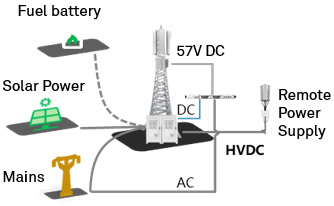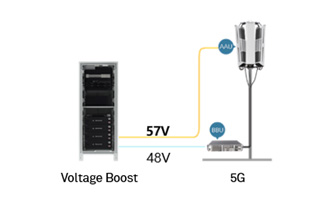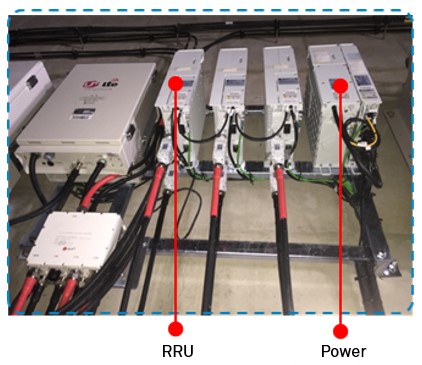5G-oriented Site Evolution
5G presents many daunting challenges for site evolution. Market insights show that only one pole can be deployed for each sector at 50% of sites. New antennas cannot be installed due to limited antenna space. The remaining capacity in existing battery cabinets is insufficient for 5G devices. Adding massive MIMO devices requires higher load bearing capabilities. How can existing sites evolve to resolve these challenges? How can 5G networks be efficiently deployed and network resources be flexibly allocated to reduce O&M costs for more complex networks?

Figure 1: Antenna challenges regarding installation space, energy, and load bearing during 5G evolution
1. Main Equipment Evolution
Huawei SingleRAN Pro aims to deploy a 5G-oriented 1+1 simplified target network to slash operator TCO, protect investments, and facilitate a smooth evolution to 5G. Any investment in existing 4G networks will produce benefits for future 5G networks. SingleRAN Pro features the following highlights:
(1) All-in-One 5G Network Compatible with 2G, 3G, and 4G
A universal hardware platform supports rapid and efficient deployment of 5G target networks and is compatible with 2G, 3G, and 4G. This will help maximize operator's return on investment in existing networks. An all-in-one 5G network extends the idea of sharing baseband and RF hardware resources among RATs in SingleRAN to maximize resource efficiency and protect operator investment. For example, besides multi-RAT antennas, an all-in-one 5G network also supports multi-band antennas. The massive MIMO device series can improve the capacity in a diverse range of scenarios. Highly integrated hardware platforms, such as integrated BBUs, play an important role in helping to accelerate the introduction of 5G, simplify sites, lower site energy consumption, and reduce overall site O&M costs.
(2) Mobile Cloud: Agile Network Architecture Supporting Multiple Operator Services
The Mobile Cloud architecture covers three aspects:
- Cloud network architecture
- Spectrum cloudification
- Cloudification of air interface capabilities
One flexible software architecture is able to meet operator requirements across an extensive array of different scenarios, including DRAN (distributed base station deployment), CRAN (centralized base station deployment), and CU-DU Split (split base station deployment).
CloudAIR allows for on-demand, dynamic resource allocation to improve spectral efficiency.
Network slicing allows for tailor-made interfaces and networks to suit a wide variety of services.
This architecture features efficient resource usage, on-demand NE deployment, and agile service provisioning, helping operators provide new services in verticals to maximize asset value.
(3) Smart Wireless Network: Automatic Management
In the 5G era, operators will encounter many unprecedented O&M challenges regarding multi-RAT coexistence, multi-service concurrency, more complex network resource management, and differentiated QoS guarantee for new services in various verticals.
AI-based network optimization, AI-based automatic O&M, and new AI network capabilities create the following value for a smart wireless network:
- Simplified and smart network O&M
- Unleashing unlimited network potential
- "Make it possible" with more and more new services and capabilities
2. Antenna Reconstruction
(1) How to Solve Insufficient Antenna Space
Market insights show that only one pole can be deployed for each sector at more than 50% of sites in a number of countries. Adding a pole costs US$ 1000 and requires more than six months for approval.
Huawei offers solutions for both single-pole and dual-pole scenarios. The 1+1 solution is preferably the most suitable for dual-pole scenarios. Massive MIMO devices and mmWave modules are installed on one pole. Passive antennas and RRUs are installed on the other pole. If the installation space is insufficient to host two poles, the all-in-one solution is recommended. Mechanical parts are used to assemble massive MIMO devices and passive antennas, which are installed on one pole.

Figure 2: 1+1 and all-in-one solutions
Passive antennas must support multiple sub-2.6 GHz bands and 4T4R to save antenna space. Such a passive antenna requires much less installation space and lowers the rental cost. A Huawei antenna developed on the GDP, Munich, or Vancouver platform supports all sub-2.6 GHz bands and 4T4R on all high-frequency bands.

Figure 3: Huawei Munich antenna platform
(2) EMF Standard Restrictions
Different countries have different laws and regulations on EMF standards. The difference is dozens or even perhaps more than one hundred times. Massive MIMO devices must reduce transmit power or in extreme cases are not allowed in a number of European countries due to EMF restrictions. For example, a country requires that the transmit power of a single sector be no more than 200 W. In this case, 5G can have no more than 100 W of transmit power, which affects contiguous coverage and performance of 5G. Improvements in technical solutions alone are incapable of supporting 5G evolution. Efforts must be made across the industry to help formulate suitable EMF standards.(3) Load Bearing of Site Foundation
A typical 5G site has two poles, one for massive MIMO devices and mmWave modules, and the other for passive antennas and RRUs. This presents a challenging new obstacle with regards to load bearing. The weight of massive MIMO devices and multi-band antennas is about 50 kg. The load bearing capabilities of the foundations for existing sites are inadequate. Poles need to be upgraded, and site foundations must be reinforced.3. Energy Reconstruction
In the 5G era, the power consumption of main equipment will double, and the power consumption of auxiliary equipment, such as temperature control equipment, will also increase. The total site power consumption will triple. This creates new challenges in terms of AC input power distribution, DC output power distribution, battery backup, and the stability of load power supply.

Figure 4: Diversified power sources
Huawei's 5G oriented power supply devices support both AC and solar power inputs. Diversified power sources improve the stability of power supply and reduce electricity fees and AC power reconstruction costs. If traditional power solutions are used for 5G sites, which have higher power consumption, for a given output voltage and a given cable cross-sectional area, the current that passes through the cable increases significantly. As a result, the voltage decreases greatly during power transmission, and the power supply requirements cannot be met. Huawei's 5G indoor blade and BoostLi power supplies can provide stable 57 V DC power and reduce voltage drop and loss during transmission. These power supplies meet power supply requirements without significantly increasing the cable cross-sectional area, reduce the site reconstruction workload and cable costs, and slash overall CAPEX.

Figure 5: Boost power supply + BoostLi
Huawei develops innovative blade power supplies for pole sites. One blade power supply is deployed for each frequency band. These blade power supplies are arranged in a stack configuration to save installation space, simplify deployment, and reduce site rental costs. These power supplies feature IP65 protection and are suitable for outdoor sites in all scenarios.

Figure 6: One blade power supply per frequency band
4. Installation
The usage of more new frequency bands increases the weight of site devices. Deployment of massive MIMO devices and multi-band antennas requires higher load bearing capabilities for site foundations. Market insights show that the load bearing capabilities of existing sites are barely enough to cater for a number of multi-band antennas and massive MIMO devices. This can have severe impacts and can potentially lead to several EHS risks. For example, the load bearing capabilities of a number of towers and poles are less than 47 kg, while massive MIMO devices are approximately 40 kg. The total weight of massive MIMO devices and the original devices exceeds the limitations of maximum load bearing capacity. Therefore, the foundations for a number of sites must be reinforced.
Heavy devices also increase installation costs. For example, in the UK and Germany, a crane is required to install a module heavier than 50 kg. The cost of renting a crane is approximately £1500 per day. During 5G site installation, Huawei partners with operators to explore new installation modes to ensure easy installation. For example, in Hangzhou, China, pulleys are used to improve the installation efficiency of massive MIMO devices and multi-band antennas. The incorporation of a fixed pulley and a free pulley helps improve the efficiency of installing massive MIMO devices by 20%. Also, massive MIMO devices can be installed on a parapet. Existing antennas do not need to be repositioned and no extra space is required, helping to significantly reduce site reconstruction costs.

Figure 7: Installation using a fixed pulley and a free pulley
Figure 8: Massive MIMO devices installed on a parapet
The Second Global Site Forum 2018 will be held in Singapore on September 18. The theme of the forum will be Full Connectivity, Optimal Experience, and Win-Win Cooperation. Huawei will present and discuss topics in regards to 5G-oriented site evolution, urban site densification, indoor digitalization, and remote coverage at the Sands Expo & Convention Center, Marina Bay, Singapore.
For more information, please visit https://www.huawei.com/minisite/globalsiteforum2018/en/index.html